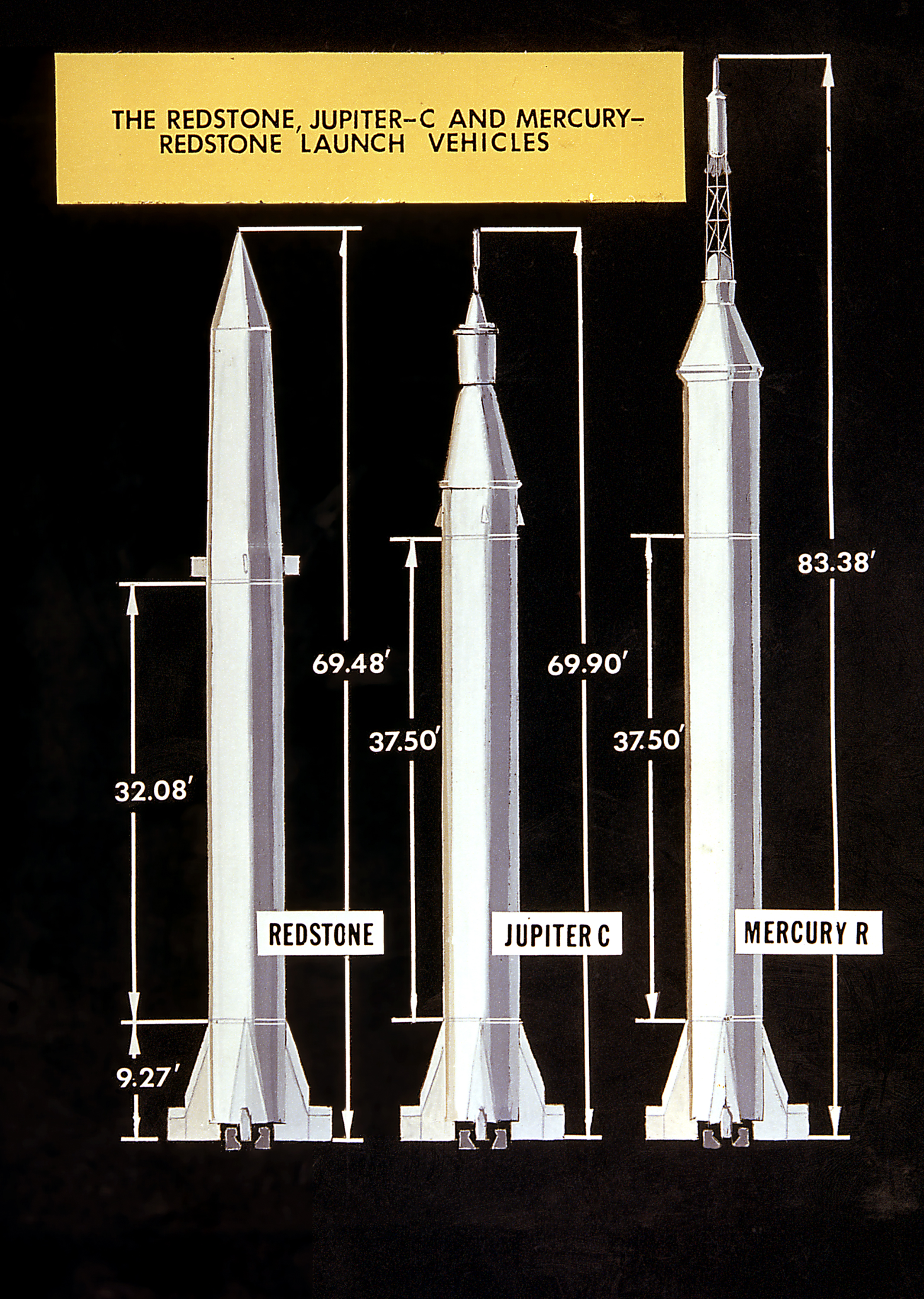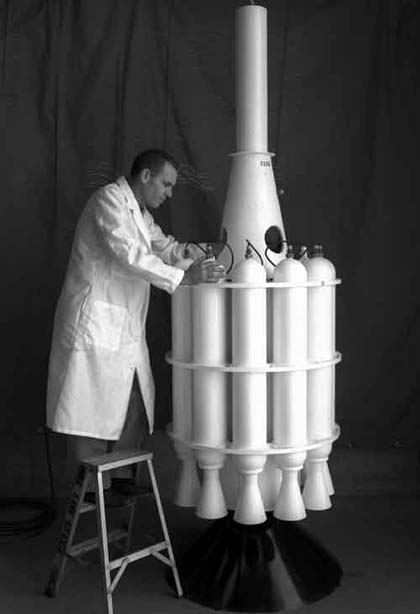Jupiter-C IRBM on:
[Wikipedia]
[Google]
[Amazon]
The Jupiter-C was an American research and development vehicle developed from the Jupiter-A. Jupiter-C was used for three unmanned sub-orbital spaceflights in 1956 and 1957 to test re-entry nosecones that were later to be deployed on the more advanced PGM-19 Jupiter mobile missile. The recovered nosecone was displayed in the Oval Office as part of President Dwight D. Eisenhower's televised speech on November 7, 1957.
A member of the Redstone rocket family, Jupiter-C was designed by the U.S. Army Ballistic Missile Agency (ABMA), under the direction of Wernher von Braun.
Three Jupiter-C flights were made followed by three satellite launches ( Juno I). All were launched from Cape Canaveral, Florida.

 The second stage was an outer ring of eleven scaled-down
The second stage was an outer ring of eleven scaled-down
Description
Each vehicle consisted of a modified Redstone ballistic missile with two solid-propellant upper stages. The tanks of the Redstone were lengthened by 8 ft (2.4 m) to provide additional propellant. The instrument compartment was also smaller and lighter than the Redstone's. The second and third stages were clustered in a "tub" atop the vehicle.
 The second stage was an outer ring of eleven scaled-down
The second stage was an outer ring of eleven scaled-down Sergeant
Sergeant ( abbreviated to Sgt. and capitalized when used as a named person's title) is a rank in many uniformed organizations, principally military and policing forces. The alternative spelling, ''serjeant'', is used in The Rifles and other ...
rocket engines; the third stage was a cluster of three scaled-down Sergeant rockets grouped within. These were held in position by bulkheads and rings and surrounded by a cylindrical outer shell. The webbed base plate of the shell rested on a ball bearing
A ball bearing is a type of rolling-element bearing that uses balls to maintain the separation between the bearing races.
The purpose of a ball bearing is to reduce rotational friction and support radial and axial loads. It achieves this ...
shaft mounted on the first-stage instrument section. Two electric motors spun in the tub at a rate varying from 450 to 750 rpm to compensate for thrust imbalance when the clustered motors fired. The rate of spin was varied by a programmer so that it did not couple with the changing resonance frequency of the first stage during flight.
The upper-stage tub was visibly spun-up before launch. During first-stage flight, the vehicle was guided by a gyro-controlled autopilot controlling both air-vanes and jet vanes on the first stage by means of servos. Following a vertical launch from a simple steel table, the vehicle was programmed so that it was traveling at an angle of 40 degrees from the horizontal at burnout of the first stage, which occurred 157 seconds after launch.
At first-stage burnout, explosive bolt
A pyrotechnic fastener (also called an explosive bolt, or pyro, within context) is a fastener, usually a nut or bolt, that incorporates a pyrotechnic charge that can be initiated remotely. One or more explosive charges embedded within the bolt a ...
s fired and springs separated the instrument section from the first-stage tankage. The instrument section and the spinning tub were slowly tipped to a horizontal position by means of four air jets located at the base of the instrument section. When the apex of the vertical flight occurred after a coasting flight of about 247 seconds, a radio signal from the ground ignited the eleven-rocket cluster of the second stage, separating the tub from the instrument section. The third stage then fired to raise the apogee
An apsis (; ) is the farthest or nearest point in the orbit of a planetary body about its primary body. For example, the apsides of the Earth are called the aphelion and perihelion.
General description
There are two apsides in any el ...
. Through this system, designed by Wernher von Braun in 1956 for his proposed Project Orbiter
Project Orbiter was a proposed United States spacecraft, an early competitor to Project Vanguard. It was jointly run by the United States Army and United States Navy. It was ultimately rejected by the Ad Hoc Committee on Special Capabilities, wh ...
, the Jupiter-C obviated the need for a guidance system in the upper stages.
Juno I
The Juno I was a satellite launch vehicle based on the Jupiter-C, but with the addition of a fourth stage, atop the "tub" of the third stage and the use of Hydyne as fuel. The Juno name derived from Von Braun wishing to make the satellite launch appear as peaceable as the Vanguard rocket, which was not a weapon, but was developed from a weather study rocket, theViking
Vikings ; non, víkingr is the modern name given to seafaring people originally from Scandinavia (present-day Denmark, Norway and Sweden),
who from the late 8th to the late 11th centuries raided, pirated, traded and se ...
. Since the Juno I was the same height as the Jupiter-C (21.2 meters), with the added fourth stage being hidden inside the shell, this vehicle which successfully launched the first orbital satellite of the United States is often incorrectly referred to as a Jupiter-C.
Encrypted serial number
The Jupiter-C was part of the IRBM project, and the sequence of manufacture of the rockets (which are not necessarily launched in order, and may be uprated as solutions to technical problems are worked out in tests) was considered a military secret. So the designation painted on the sides of the rocket was not a serial number inclear text
In cryptography, plaintext usually means unencrypted information pending input into cryptographic algorithms, usually encryption algorithms. This usually refers to data that is transmitted or stored unencrypted.
Overview
With the advent of co ...
, but employed a simple transformation cypher that the staff would be sure not to forget. The key was taken from the name of the design and test base: Huntsville, Alabama, giving HUNTSVILE, with duplicated letters dropped: H was used for 1, U for 2, ..., E for 9 and X for 0.
For example, the Jupiter-C modified to launch Explorer 1
Explorer 1 was the first satellite launched by the United States in 1958 and was part of the U.S. participation in the International Geophysical Year (IGY). The mission followed the first two satellites the previous year; the Soviet Union's S ...
had "UE" painted on the side, indicating it was S/N 29 (U→2, E→9).
General characteristics
* Weight as configured forExplorer 1
Explorer 1 was the first satellite launched by the United States in 1958 and was part of the U.S. participation in the International Geophysical Year (IGY). The mission followed the first two satellites the previous year; the Soviet Union's S ...
launch, loaded/empty
** Overall, takeoff: 64,000 lb (29,000 kg)/10,230 lb (4640 kg)
** Stage 1 62,700 lb (28,400 kg)/9,600 lb (4,400 kg)
** Stage 2 1,020 lb (460 kg)/490 lb (220 kg)
** Stage 3 280 lb (130 kg)/140 lb (64 kg)
* Propulsion
** Stage 1: Rocketdyne
Rocketdyne was an American rocket engine design and production company headquartered in Canoga Park, in the western San Fernando Valley of suburban Los Angeles, in southern California.
The Rocketdyne Division was founded by North American Avia ...
A-7 engine
*** Thrust, 83,000 lbf (370 kN)
*** burning time, 155 s
*** specific impulse, 235 s (2.30 kN·s/kg)
*** propellants, liquid oxygen, as oxidizer, and alcohol as fuel
*** propellant feed, turbopump type
*** turbopump drive, 90% hydrogen peroxide decomposed by catalyst bed to produce steam
** Stage 2: Eleven JPL scaled-down Sergeant rockets
*** Thrust, 16,500 lbf (73 kN)
*** burning time, 6.5 s
*** specific impulse, 220 s (2.16 kN·s/kg)
*** propellant, polysulfide-aluminum and ammonium perchlorate (solid propellant)
** Stage 3: Three JPL scaled-down Sergeant rockets
*** Thrust, 4,500 lbf (24 kN)
*** burning time, 6.5 s
*** specific impulse, 235 s (2.30 kN·s/kg)
*** propellant, same as for Stage 2
Flight history
* September 20, 1956: lifted an 86.5-lb (39.2 kg) payload (including a 30-lb (14 kg) dummysatellite
A satellite or artificial satellite is an object intentionally placed into orbit in outer space. Except for passive satellites, most satellites have an electricity generation system for equipment on board, such as solar panels or radioiso ...
) to an altitude of 680 mi (1,100 km), a speed of 16,000 mph (7 km/s), and a range of 3,300 mi (5,300 km) from Cape Canaveral
, image = cape canaveral.jpg
, image_size = 300
, caption = View of Cape Canaveral from space in 1991
, map = Florida#USA
, map_width = 300
, type = Cape
, map_caption = Location in Florida
, location ...
, Florida
* May 15, 1957: lifted a 300 lb (140 kg) scale Jupiter ablative nose cone to an altitude of 350 mi (560 km) and a range of 710 mi (1,100 km)
* August 8, 1957: lifted a 1/3-scale Jupiter nose cone to an altitude of 285 mi (460 km) and a range of 1,330 mi (2,140 km); Juno I (four-stage configuration).
* January 31, 1958: launched the Western world's first satellite, Explorer 1
Explorer 1 was the first satellite launched by the United States in 1958 and was part of the U.S. participation in the International Geophysical Year (IGY). The mission followed the first two satellites the previous year; the Soviet Union's S ...
References
Bibliography
{{cite book , last = West , first = Doug , title = Dr Wernher von Braun: A Short Biography , location = US, year = 2017 , isbn = 978-1-9779279-1-0 1956 in spaceflight Sounding rockets of the United States Space launch vehicles of the United States